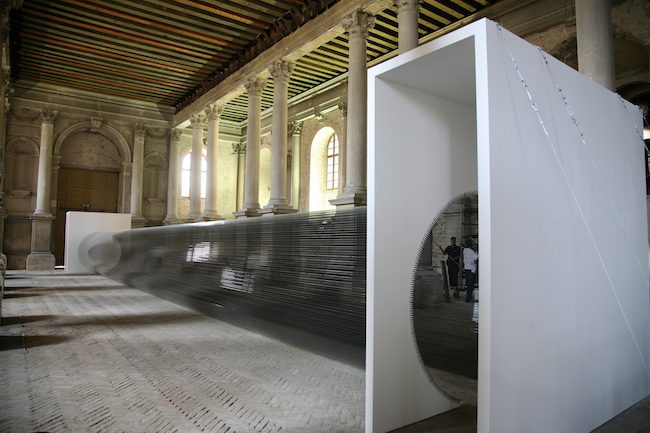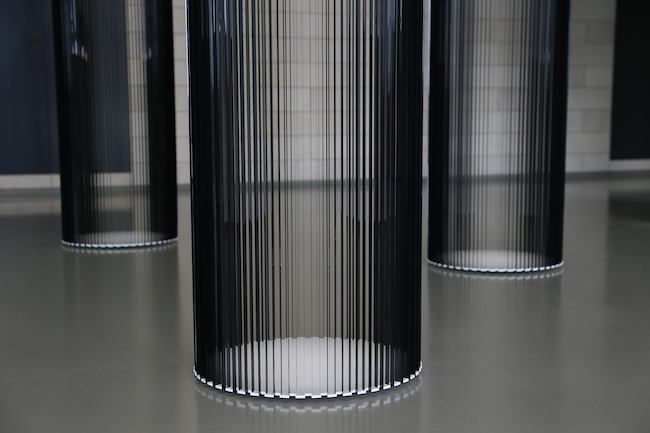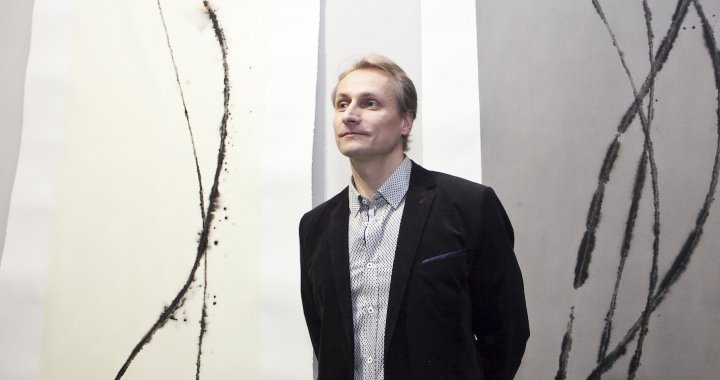
The process itself becomes an art piece
An interview with Lithuanian artist Žilvinas Kempinas
Odrija Fišere
18/01/2017
The works of New-York based Lithuanian artist Žilvinas Kempinas (1969) are often filed into categories such as “minimalistic”, “abstract”, and “kinetic”. Kempinas avoids labeling himself in that way, and emphasizes that movement, space and light – in combination with the viewer’s perception – is what interests him; consequently, his works can be fully experienced only in person. Another one of his traits is experimentation with a variety of mediums and materials, such as the magnetic tape from VHS cassettes, with which he likes to create his visually intense installations, such as: White Noise, his work from 2007 which brought to mind the white “snow” one sees on a TV screen when it’s not tuned to a channel; or the piece Columns, (2006); and, of course, Kempinas’ large-scale installation Tube (2008) – a twenty-five-meter-long tunnel made from videotapes. This literally-vibrating piece, which was exhibited at the Lithuanian pavilion at the 53rd Venice Art Biennale in 2009, also hinted at the waters of Venice, and created a visual and physical experience so strong that it very nearly obscured its viewers’ reference points in time and space.
Žilvinas Kempinas. Tube, 2009. Installation view at Scuola Grande della Misericordia, Lithuanian pavilion in Venice biennale, 2009. Photo from personal archive
In his interviews, Kempinas has revealed that he began to use a wide range of magnetic tape in his works not only because of its conveniently long length, but also in regard to its intrinsic nature of being completely unlike a traditional painting encapsulated in one rectangular frame – on VHS or celluloid tape, the images are continuous, and it is impossible to see them all at once. Although videotape is a vessel for visual information, it can also be perceived as an abstract line; in addition, it is sensitive to the lightest stirring of the air. These are the qualities that have inspired Kempinas to create his most famous sculptures in which air currents play a great part.
Žilvinas Kempinas. Columns, 2006. Installation view at National Gallery of Art, Vilnius, 2014. Photo from personal archive
Žilvinas Kempinas is always mentioned when the topic is Baltic art “success stories”. And rightfully so, for he is one of the few Baltic artists whose name has been associated with Europe’s largest art shows and world-famous museums. Whereas the Venice Biennale has served as a career launchpad for quite a few emerging artists, for Kempinas, this milestone seems to have come earlier, namely, in New York. After graduating from Hunter College, City University of New York, his solo shows at the Spencer Brownstone gallery (2004, 2006, 2007) attracted the attention of not only art critics, but also that of Martin Margulies, owner of the Margulies Collection. As a result, Kempinas’ installations Columns and Bike Messenger (2006) were acquired by the influential collection, and were exhibited at Art Basel Miami 2006. That was followed by winning the 2007 Calder Prize and a residency at Atelier Calder in Saché, France, and solo shows at numerous institutions: Palais de Tokyo, Paris (2006); the Contemporary Art Centre, Vilnius (2007); Kunsthalle Wien, Vienna (2008); Museum Tinguely, Basel (2013); Kunstsammlung Nordrhein-Westfalen, Düsseldorf (2013); and the Reykjavik Art Museum (2013). Kempinas’ installations were shown in Manifesta 7 (2008), the Liverpool Biennial (2010), as well as in group shows at New York’s MoMA (2010) and the MUDAM Modern Art Museum in Luxembourg (2010), to name but a few. The artist’s latest works, along with variations of older pieces, were on view in autumn 2016 at the IKON gallery in Birmingham, and then at the Vartai gallery in Vilnius. This year for him has started with a solo show at Dartmouth College in New Hampshire, USA.

Žilvinas Kempinas. Tube, 2009. Installation view at Scuola Grande della Misericordia, Lithuanian pavilion in Venice biennale, 2009. Photo from personal archive
We met at Vartai gallery in Vilnius, a few moments before the opening of his exhibition (on view through February 3, 2017). Five of Kempinas’ Illuminators brightly glow in the darkened space of the gallery, and not too far away one can hear White Noise; after strolling through the hypnotizing Forest, you arrive in one of two lit rooms where you are faced by Oasis – a magnetic tape undulating in the center of the room with the help of a fan – and the shapes it generates are seemingly recreated in two huge paintings that hang on the wall.
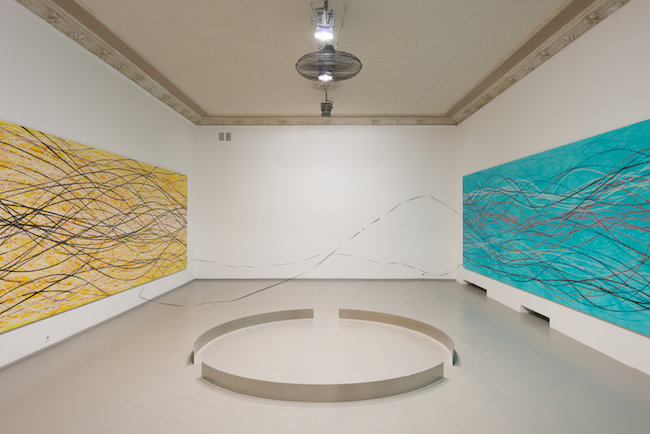
Žilvinas Kempinas. Ride #7 (2016), Oasis (2010), Ride #6 (2016). Exposition at Vartai Gallery, 2016. Photo: Arnas Anskaitis
Have you shown your paintings before?
These are brand new works, made last summer, and I included them here in my show at Vartai Gallery. I made them with a bicycle riding on a canvas, therefore, they recall paintings, but technically, they are related to prints as well. This was my latest exploration of gravity, speed, and the mechanics involved, tracing the movement of my own body through physical space, and “recording” the shapes of lines that way.
Movement is present in many of your installations; also in Untitled (Forest).
I prefer to have this work as abstract as possible, so I have projections upside down, and you can only see the play of light and the movement of shapes – various branches here are moving towards you and away from you at different speeds and rhythms, depending on their distance to the camera; the tripods I’ve used “act” as some kind of stretched screens, and the four screen projectors used there inevitably reminds the sunbeams. I am following my interest in movement, in the ideas of how we can transform energy, how we can transform space, how we can use light, how one can manipulate people’s perception with a few basic elements, how to provoke certain feelings, how to balance, how to create a situation for random things to occur – all of these things matter.
This reminds me of the outdoor installation that you did during your residency at Atelier Calder, in Saché.
Yes, I use the same structure painted white and adapted to the size of the gallery space. Occasionally, I continue working with the same idea if I like it, and I develop it a step further.
Žilvinas Kempinas. Columns, 2006. Installation view at National Gallery of Art, Vilnius, 2014. Photo from personal archive
Is it true that you never write down or sketch out your ideas? And that you even try to forget them, and only use them if they keep coming back?
Yes, that’s true. I guess they come and go for everybody. For me, the way to sort them into “valuable” or “not valuable” is to see if the same ideas keep coming back, if they continue to bother me. I work only with ideas which are visually strong; I’m not interested in the idea per se, or a narrative, or some kind of a “message”. I prefer only ideas that I cannot quite put into words – they have to come into being via materials, space, light, time and other elements, both visible and invisible. If I can explain an idea precisely with words, I see no point in making it. It would be boring for me.
So you are interested in providing visual satisfaction?
Certain visual aesthetics, perhaps, but “satisfaction” is not the right word since my works can also be disturbing – sometimes people even feel vertigo... One way or another, I seek to make my works visually engaging; then, it hopefully goes on to make a connection with one’s personal experiences, emotions, imagination, etc.
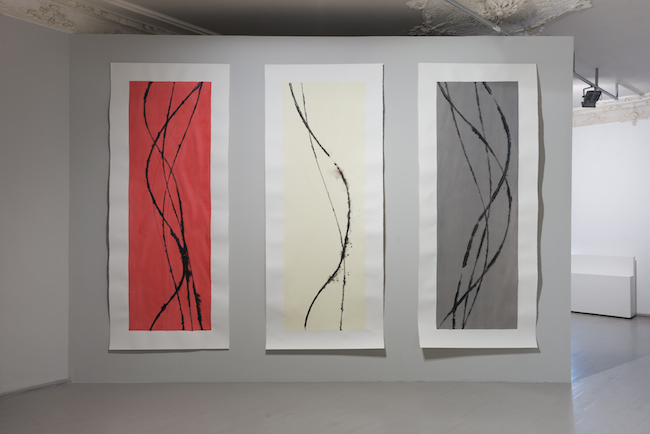
Žilvinas Kempinas. Cycle drawing # 2 (2016), Cycle drawing # 18 (2016), and Cycle drawing # 17 (2016). Exposition at Vartai Gallery, 2016. Photo: Arnas Anskaitis
Taking into consideration that your works are based on how the laws of physics work, are you also interested in physics?
I am, but actually, these are quite simple physics. I rely on my experiments. I was pretty bad in physics at school [laughs]. It is visual art that deals with the physical world. I explore that. I use my knowledge about some basic perceptual curiosities. For example, if you look at Illuminators – in reality, the white part is a little bit further away than the black part, but it looks as if the opposite is true. It’s just an illusion – a white and shining object always looks closer than the black matte field around it, so we see it as a background even if, technically, that is not the case. Your eyes are tricked. And then you can “read” this object as being an image of a planet, or of the moon. That’s because the moon, in itself, is a very iconic image; all generations of humans have seen the same moon, so it is in our DNA, and when you see something similar, you just instantly “recognize” it as a moon. That’s how our mind operates. It can steer you in the direction of thinking about a romanticized celestial body, but then you come closer and see that there is nothing much but a rough wall lit. It stands somewhere between pictorial illusion and reality, and this I find intriguing.

Žilvinas Kempinas. Illuminators (2015), White noise (2007), and Bearings (2015). Exposition at Vartai Gallery, 2016. Photo: Arnas Anskaitis
Here, Illuminators are in the same room with Bearings. Are those works related somehow, besides the fact that both were made by you?
In some ways you can find connections between them, but the object Bearings is more related to my works with tape. The tape, basically, creates different shapes with every second because of the circulated air. It is constantly changing. Since I had already worked with tape for quite a few years, I was very keen on doing something with more “traditional materials” [laughs], such as steel. How can one make steel move and rearrange itself? This is how I came upon the idea of using round particles (bearings) and a system of rotating magnets underneath. It resulted in this slowly moving and changing shape, and it is up to you to decide whether you want to see it as a flat surface or as a three-dimensional object. Either way, this piece is constantly rearranging itself – there is no end to that.
So, it is never finished?
Yes, it is perpetual, and it exists on its own terms. The endless process itself becomes a piece. I just set a situation for it.
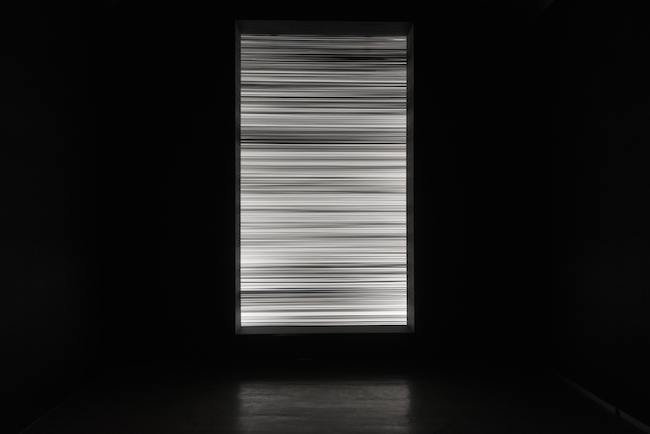
Žilvinas Kempinas. White noise, 2007. Exposition at Vartai Gallery, 2016. Photo: Arnas Anskaitis
For some artists, the process of making art is a sort of ritual – a meditation. What is it like for you? Is it all about experimentation?
For some of my works, I just have sat and waited until it falls down; then I make changes and wait again. I don’t think it is meditation… In other cases, the process has been more labor-intensive. For example, my Stars series – technically, it was very difficult to make because it is a resin, and I did all of the casting myself. To make it properly, it needed perfect timing, the perfect conditions, and lots of discipline. That’s something that I really liked. That’s also probably one of the reasons why I started to do the pieces for Stars series – I was missing the pure craft aspect in my work. And then there are some works that are based more on experimentation – like White Noise.
Do you remember the moment at which you decided to become an artist?
I was two years old when I said – “I want to be an artist”.
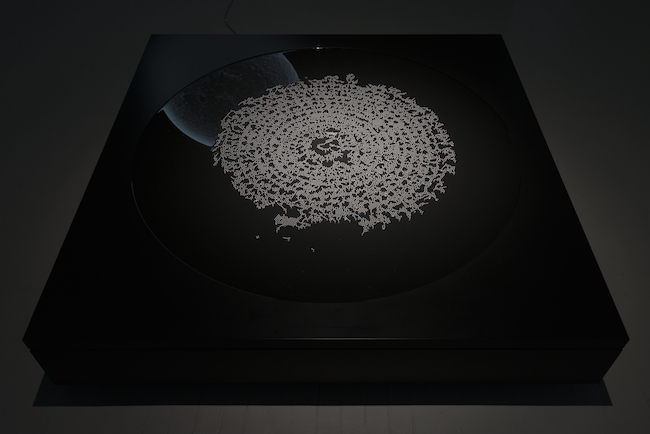
Žilvinas Kempinas. Bearings, 2015. Exposition at Vartai Gallery, 2016. Photo: Arnas Anskaitis
Really?
That’s what my mom says, I don’t remember myself. I just stated it, and never changed my mind, actually. I don’t know where the idea came from. Maybe because of my dad – he was always quite respectful in regards to art. He is not an artist, but he used to teach literature, stage language, and pronunciation. At some point, he worked in an art museum as a guide. The museum was filled with old paintings. I would follow him and listen to how he would talk – as if he were on stage; he is very good at that. So, he was very engaging, and soon enough, I knew everything about the paintings. I was ten to twelve years old then. However, I wasn’t really drawing or painting passionately, but I was fairly good in my class, I mean slightly better than others. I remember I once did a drawing with a ship, and our cool art teacher told me – “I really can’t teach you anything more”. At the time, I was also learning clarinet at music school, which I really hated. The teacher told my parents to switch music school for an art classes.
After four years at art school, I did one year of preparation for the Vilnius Art Institute (later – the Vilnius Art Academy), and then I was accepted to the Department of Painting. I went for painting just because I thought that a true artist should be a painter.
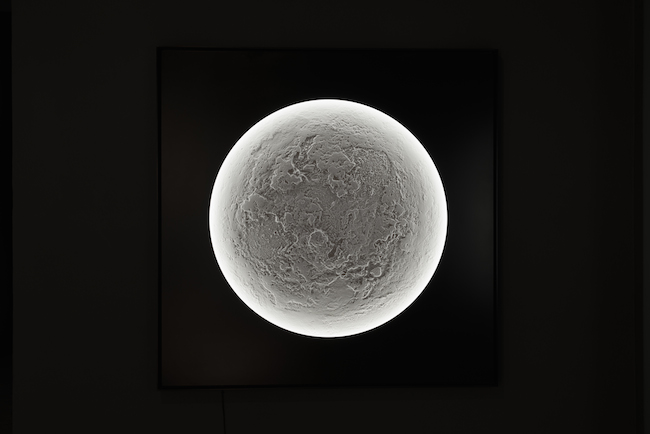
Žilvinas Kempinas. Illuminator XXV, 2015. Exposition at Vartai Gallery, 2016. Photo: Arnas Anskaitis
After I graduated from the Art Academy, I stayed in Vilnius for about five years – I did three solo shows, and some group shows with the group Good Evils – we were a group of young art hooligans. I also did the set design for a theatrical play directed by Oskaras Koršunovas. Those five years were really intense and fun. Afterwards, I realized that I want to experience more and that I want to learn more – so I went to New York with an open mind, just to see how things would go. I didn’t do much but explore at first, to see if I would like it – and I did, so I stayed. I applied to Hunter College, City University of New York. I didn’t have to study for a degree, because I already had my graduate degree, but nevertheless, it was useful as a starting point. In addition, I got an art studio and a student visa that way.
Did New York change the way you look at art?
Of course it did. It changed me as well.
Do you feel free as an artist?
I think so. I’m free within my own set of rules [laughs] and then I try to break them.
Žilvinas Kempinas. Untitled (Forest). Installation at Gallery Vartai, 2016-2017
